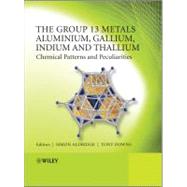
Note: Supplemental materials are not guaranteed with Rental or Used book purchases.
Purchase Benefits
Looking to rent a book? Rent The Group 13 Metals Aluminium, Gallium, Indium and Thallium Chemical Patterns and Peculiarities [ISBN: 9780470681916] for the semester, quarter, and short term or search our site for other textbooks by Aldridge, Simon; Downs, Anthony J.. Renting a textbook can save you up to 90% from the cost of buying.
Professor Anthony J. Downs
The scopy of Professor Downs' research takes in the synthesis and chemistry of novel inorganic and organometallic compounds, mostly of the typical elements but also of transition metals. He has authored or edited more than 200 publications, including 27 books and review articles.
Preface ix
List of Contributors xi
1 New Light on the Chemistry of the Group 13 Metals 1
Anthony J. Downs and Hans-Jo¨rg Himmel
1.1 Reprise of the General Features of Group 13 Elements 1
1.2 Developments in Methodology 6
1.3 Redox Chemistry of the Group 13 Metals: Access to Oxidation States Lower than +3 25
1.4 Bonding Aspects 28
1.5 Solid Compounds with Specific Electronic, Structural or Other Properties 38
1.6 Coordination Chemistry of M(III) Compounds 43
1.7 Mediation of Organic Transformations by Group 13 Metal Compounds 57
References 60
2 The Chemistry of the Group 13 Metals in the +3 Oxidation State: Simple Inorganic Compounds 75
Simon Aldridge
2.1 Introduction 75
2.2 Hydrides 76
2.3 Halides and Pseudo-Halides 99
2.4 Oxides and Oxo- Derivatives 107
2.5 Chalcogenides and Chalco-Derivatives 118
2.6 Compounds with Bonds to Group 15 Atoms 122
References 132
3 Formal Oxidation State +3: Organometallic Chemistry 148
Simon Aldridge, Anthony J. Downs and Deborah L. Kays
3.1 Introduction 148
3.2 Organo Derivatives with a Metal–Carbon Primary Framework 151
3.3 Derivatives with Bonds to Group 15 Elements 168
3.4 Derivatives with Bonds to Group 16 Elements 192
3.5 Organometal Halides 210
3.6 Organometal Hydrides 215
3.7 d-Block and f-Block Compounds with Organo-Group 13 Metal(III) Fragments 220
References 227
4 Formal Oxidation State +2: Metal–Metal Bonded Versus Mononuclear Derivatives 246
Werner Uhl and Marcus Layh
4.1 Introduction 246
4.2 Subhalides Containing M–M Bonds 247
4.3 Homoleptic Chalcogen Compounds 250
4.4 Homoleptic Dielement Compounds with Pnicogen Atoms Coordinated to the M–M Bonds 251
4.5 Heteroleptic Compounds Containing Donor Atoms of Groups 15 to 17 254
4.6 Homoleptic Dinuclear Organoelement(II) Compounds 257
4.7 Heteroleptic Organoelement(II) Compounds 265
4.8 Mononuclear Element(II) Compounds 274
References 277
5 The Chemistry of the Group 13 Metals in the +1 Oxidation State 285
Cameron Jones and Andreas Stasch
5.1 Introduction 285
5.2 Aluminium 286
5.3 Gallium 298
5.4 Indium 310
5.5 Thallium 317
References 329
6 Mixed or Intermediate Valence Group 13 Metal Compounds 342
Benjamin F. T. Cooper and Charles L. B. Macdonald
6.1 Mixed Valency 342
6.2 Halides 346
6.3 Arene-stabilised Mixed Valent Species 353
6.4 Chalcogenide and Other Non-Halide Salts 363
6.5 Discretely Bonded Systems 368
6.6 Donor–Acceptor Compounds 390
6.7 Conclusions 396
References 397
7 Aluminium and Gallium Clusters: Metalloid Clusters and their Relationship to the Bulk Phases, to Naked Clusters and to Nanoscaled Materials 402
Hansgeorg Schno¨ckel and Andreas Schnepf
7.1 Introduction 402
7.2 Explanations of Special Terms 404
7.3 The Naked Al13 Cluster 407
7.4 Metalloid Al/Ga Clusters 416
7.5 Interactions between Cluster Species within the Crystal 471
7.6 Summary and Outlook 480
References 482
8 Simple and Mixed Metal Oxides and Hydroxides: Solids with Extended Structures of Different Dimensionalities and Porosities 488
Andrew M. Fogg
8.1 Introduction 488
8.2 The Parent Oxides and Hydroxides 489
8.3 Layered Materials 494
8.4 Framework Materials 502
References 509
9 Coordination and Solution Chemistry of the Metals: Biological, Medical and Environmental Relevance 519
Penelope J. Brothers and Christy E. Ruggiero
9.1 Introduction 519
9.2 Hydrides 521
9.3 Halides 542
9.4 Group 13 Complexes of N-donor Ligands 548
9.5 Complexes of the Monovalent M(I) Group 13 Metals 557
9.6 Divalent M(II) Complexes 568
9.7 Chemistry Relevant to Environmental and Biological Systems 569
9.8 Environmental Abundances, Uses and Sources 572
9.9 Biological Systems 576
References 593
10 III–V and Related Semiconductor Materials 612
Mohammad Azad Malik and Paul O’Brien
10.1 Introduction 612
10.2 III–Nitrides 619
10.3 III–Phosphides 627
10.4 III–Arsenides 631
10.5 III–Antimonides 636
References 645
11 Group 13 Metal-Mediated Organic Reactions 654
Samuel Dagorne and Ste´phane Bellemin-Laponnaz
11.1 Aluminium 654
11.2 Gallium 675
11.3 Indium 681
11.4 Thallium 688
References 692
Index 701
The New copy of this book will include any supplemental materials advertised. Please check the title of the book to determine if it should include any access cards, study guides, lab manuals, CDs, etc.
The Used, Rental and eBook copies of this book are not guaranteed to include any supplemental materials. Typically, only the book itself is included. This is true even if the title states it includes any access cards, study guides, lab manuals, CDs, etc.